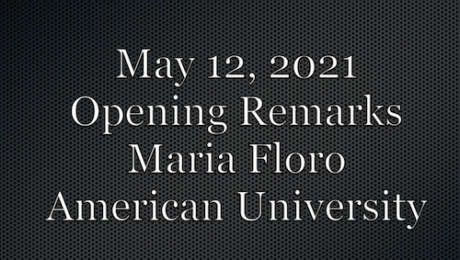The Journey of the Care Work and the Economy Project
As the CWE-GAM project is coming to a close, the final activities in the summer of 2021 showcased the groundbreaking research that was conducted over the past year and prompted valuable conversations between researchers, activists, donors, and more. Professor Maria Floro, the Co-Principal Investigator of the project, launched the Concluding Annual Meeting with opening remarks that summarized the timeline, features, and accomplishments of the project.
The Care Work and the Economy project began in 2017 and was built around the fundamental research goals of highlighting the impact of care work, socially and economically, and emphasizing the need for policy agendas to address the care economy. The project’s working groups consisted of innovative, interdisciplinary researchers who brought expertise and toolkits from a variety of schools of thought including heterodox, feminist, political economy, structural, and mainstream economics. The project used South Korea as a case study for the care economy which was made possible by a strong partnership with Korean researchers and the collection of unique time use and household survey data by the Center for Transnational Migration and Social Inclusion at Seoul National University.
Over the course of the past four years, the project has hosted two annual meetings, two conferences with Korean advocacy groups, and virtual workshops during the Covid pandemic. Additionally, the project produced two policy tools for the Korean government, 33 working papers showcased on the project website, and special issues in Feminist Economics and World Development. The final two activities conducted by the project were the Seoul Policy Dialogue in early June and a virtual intensive course on Gender-Sensitive Macroeconomic Modelling for Policy Analysis in partnership with the Levy Institute at Bard College.
To watch the full Opening Remarks of Professor Maria Floro from the Concluding Annual Meeting, see below.
Written by Catherine Falvey, Research Assistant for the Care Work and the Economy project and PhD student in Economics at American University
- Published in Conferences, Expert Dialogues & Forums, Maria Floro
What is the Care Economy and Why Should We Care?
In our project, we aim to promote and advocate for gender and socioeconomic equalities. We do this by working to reduce gender gaps in economic outcomes and by showing and properly valuing social and economic contributions of caregivers; and integrating care into macroeconomic policy making toolkits.
In this era of demographic shifts, economic change and chronic underinvestment in care provisioning, innovative policy solutions are desperately needed, now more than ever. Sustainable and inclusive development requires gender-sensitive policy tools that integrate new understandings of care work and its connections with labor market supply and economic and welfare outcomes.
The Care Work and the Economy Project, currently based at the Economics Department of American University and co-led by Maria S. Floro and Elizabeth King, includes more than 30 scholars around the globe, working closely together to provide policy makers, scholars, researchers and advocacy groups with gender-aware data, empirical evidence and analytical tools needed to promote creative macroeconomic and social policy solutions. In the next phase of the project, Care Economies in Context, we will be scaling up our project to include 8 different countries, in 4 global regions. I will be leading this next phase of the project, which will be based at the University of Toronto.
I define Care work is defined broadly as work and relationships that are necessary for the health, welfare, maintenance and protection of all people – young and old, able bodied, disabled, and frail. This definition may seem broad – but care– at its core is a very basic human need and a necessity. Whether we know it or now, we all participate in providing care work – paid or unpaid, and in receiving care every day.
By care economy, I am referring to the sector of economy that is responsible for the provision of care and services that contribute to the nurturing and reproduction of current and future populations. More specifically, it involves child care, elder care, education, healthcare, and personal social and domestic services that are provided in both paid and unpaid forms and within formal and informal sectors.
Care work is important because it is important work that sustains life. It is also important now in particular because it is one of the fastest expanding economic sectors and a major driver of employment growth and economic development around the world. For example, across the OCED, the service sector economy now accounts for over 70 percent of total employment and GDP. In lower- and middle-income countries, it is estimated to comprise nearly 60 percent of GDP. Within the service sector economy, care services is one of the fastest growing subsectors.
The International Labour Organization (ILO) estimates that the global employment in care jobs is expected to grow from 206 million to 358 million by 2030 simply based on sociodemographic changes. The figure will be even more dramatic to 475 million if governments invest resources to meet the UN sustainable development goal targets on education, health, long-term care and gender equality.
In Canada, the service sector already makes up for 75 percent of employment and 78 percent of GDP. Within this sector, healthcare, social assistance and education services are key drivers of economic and employment growth. In the U.S., healthcare is already the largest employer, larger than steel and auto industries put together. In short, our current and future economy is and will be increasing dominated by care services and care work.
However, at the same time, much of the care work continues to be performed for no pay, by families and friends, at home and in communities. This unpaid care work is not including in in our national GDP because GDP only takes into account work that is done for pay in the formal market. Therefore, if we only look at the GDP as a measure of the economy and economy growth, we miss a huge segment of the economy and economic activities. As the pandemic has shown, without both paid or unpaid care work, our economy will not be able to function effectively, nor would it be able to sustain itself.
What we are trying to do in our project is to make the care economy clearer and more visible by measuring and mapping out the size and shape of the economy, and to develop macroeconomic models that would help policymakers and civil society actors to develop better policies and better strategies to ensure more sustainable and equality inducing economic growth.
Listen to the full talk “The Care Work and the Economy Project” to learn about what the care economy is and why we should know more about it, particularly now.
The blog was authored by Ito Peng, contributing researcher for the Understanding and Measuring Care research cluster
- Published in Canada, Child Care, Economic Modeling, Elder Care, Expert Dialogues & Forums, Feminist Economics, OECD
Engendering the Macroeconomy: Current Efforts and Future Directions
On International Women’s Day earlier this month, the Whitaker Institute hosted a webinar titled “Engendering the Macroeconomy: Current Efforts and Future Directions” featuring Dr. Maria S. Floro, Principal Investigator of the Care Work and the Economy Project (CWE) and CWE contributing researcher Dr. Srinivasan Raghavendra. Dr. Raghavendra also serves as Co-PI of DFID funded research on “Economic and Social Costs of Violence Against Women and Girls.” This session was hosted by Dr Nata Duvvury, co-leader of the Gender and Public Policy cluster at the Whitaker Institute.
The webinar focused on exploring what engendering the macroeconomy entails, current efforts, and future directions. The discussion provides insight into ways to bring gender dimensions into macroeconomics by incorporating unpaid and paid care of children, the sick, disabled and the elderly into existing macroeconomic models, the interdependency between the market economy and the care economy, and how gender blindness of macroeconomic models are reflected through every crisis.
This blog was authored by Jenn Brown, CWE-GAM Communications Assistant.
- Published in Economic Recovery, Expert Dialogues & Forums, Gender-Equal Economy, Macroeconomics
Macroeconomic Policies, Care and Gender in the Post-COVID Era: Part II
Faculti, an organization that presents digital media from leading experts and academics outlining their work, recently released a digital presentation by the Care Work and the Economy Principal Investigator Dr. Maria S. Floro entitled “Macroeconomic Policies, Care and Gender in the Post-COVID Era.” The discussion describes the interconnections between the crisis of care, the deepening ecological crisis and growth and accumulation processes.
There are many common threads with the climate and ecological crisis and the care crisis. Significantly, the idea that economic growth is overall beneficial. The type of economic growth generally pursued worldwide has not only increased stresses put upon the earth’s resource base but also on care labor capacity, which is similarly but wrongly perceived to be of infinite supply. Moreover, arguments that equate economic growth with overall improvement fail to recognize the distributional element of rising income inequality, which is far more nuanced. In fact, among countries that are higher income, gains from economic growth within those nations do not trickle down to everyone. When looking at care, the widening income equality gaps has shifted distribution of care givers across social classes and national boundaries. As a result, the quality and adequacy of care within a single nation can be very different, which exacerbates differences in social reproduction.
At the same time, income inequality has created a solution for the care needs of those that have the means to hire care for children and elderly, because care workers in those sectors are often paid low wages. But for the working poor, hiring care work help is inaccessible due to financial constraints, therefore they rely on their kinship networks to help provide this care. Furthermore, much of the care work burden still falls on women even as they enter to labor force. Economics and social policy in many parts of the world continue to neglect the heavy work burden put upon women and the necessity to balance household care activities and market work. What can also be observed is a global care supply chain, with the migration of women and girls to urban areas to provide care for wealthier families. Care itself is becoming one of the drivers of income inequality.
The economy is not all about material production; it is really about human vision and social provisions. However, an illusion has been created that unpaid care work is a natural resource that serves as an input for market production to promote GDP growth. However, this idea does not take into account that the wellbeing of people, especially the elderly, the sick and children should be an end in and of itself, to achieve sustainable growth. There is much work to be done to address these issues. To begin, economists must envision long term horizons that look forward to future generations while also taking into account the interdependence of life and moral responsibility. They must also integrate care and environmental consequences into our economic policy tools. Overall a new economic paradigm that includes green ecology and feminist economic concerns is needed.
Link to Part 1 of this blog here.
Unpaid Work, Animated
About half of all the time devoted to work in the U.S. is devoted to unpaid work in the home. The Institute for New Economic Thinking has created an adorable animation of some comments I made in an interview with them on this topic a while back.
It’s quite a lot of fun, and basically accurate. Just don’t pay too much attention to the numbers they inserted into my discussion of two families, each with a market income of $50,000–the animation seems to imply that leisure should be assigned a monetary valuation–not something I advocate. Still, the main point comes through just fine: conventional measures provide a misleading picture of living standards.
The animation provides a great introduction to the topic for students, and you can find a more academic version of the basic argument in a short briefing paper I wrote for the Washington Center for Equitable Growth.
Original blog published on CARE TALK: FEMINIST AND POLITICAL ECONOMY on June 11, 2020. See here for the original posting.
Reposted with permission from Dr. Nancy Folbre from University of Massachusetts Amherst and an expert researcher for the Care Work and the Economy Project within the Rethinking Macroeconomics working group.
- Published in Expert Dialogues & Forums, Feminist Economics, Rethinking Macroeconomics
- 1
- 2






